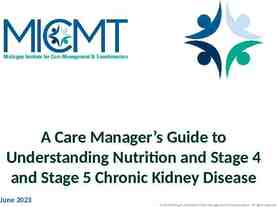TIME CRITICAL DIAGNOSIS SYSTEM in MISSOURI Right Care. Right Place.
41 Slides1.42 MB
TIME CRITICAL DIAGNOSIS SYSTEM in MISSOURI Right Care. Right Place. Right Time.
Right Care. Right Place. Right Time.
Meeting Purpose Why Time Critical Diagnosis Matters STEMI, Stroke, Trauma Patient Care The Trauma System Model Implementation: Progress and Goals Missouri Regulations Next Steps Right Care. Right Place. Right Time.
Why Time Critical Diagnosis System Matters: Leading causes of death in Missouri 1st Heart Disease, including ST-Elevation Myocardial Infarction (STEMI) 3rd Stroke 4th Trauma-injury-accidents, motor vehicle accidents, suicide, homicide, other; Leading cause of YPLL Right Care. Right Place. Right Time.
TCD Project History 2003 – Missouri Foundation for Health (MFH) identified the need for EMS/Trauma Reform 2005 – Dr. Bill Jermyn accepts State EMS Medical Director Position 2006 – Emergency Medical Care System planning ‘07-08 – TCD Task Forces (Stroke/STEMI and Trauma) 2008 – Authorizing Legislation 2008 –Time Critical Diagnosis stroke and STEMI implementation teams 2009 – ACS COT Review 2010 –NHTSA Review Right Care. Right Place. Right Time.
TCD System Goal Prompt treatment reduces death and disability. Right Care. Right Place. Right Time.
Why Time Critical Diagnosis Matters Prompt treatment reduces death and disability. HEART DISEASE Outcomes for heart attack victims can be improved with an integrated care delivery system. STEMI, ST-Segment Elevation Myocardial Infarction, is a common form of heart attack that is time critical. Right Care. Right Place. Right Time.
Why Time Critical Diagnosis Matters Prompt treatment reduces death and disability. STEMI Shorter time from door-to-balloon (PCI) - lower risk of mortality – Moving towards first medical contact to balloon Symptom onset to treatment time greater than 4 hours independent predictor of one-year mortality Faster treatment and lower in-hospital mortality associated with hospital “specialization” and emphasis on PCI as principal mode of reperfusion Right Care. Right Place. Right Time.
Why Time Critical Diagnosis Matters Prompt treatment reduces death and disability. STROKE Missouri-ranks 7th in stroke prevalence Missouri’s stroke death rate – 11% higher than national rate 15-30% will be disabled (leading cause of disability) 20% require institutionalization first 3 months poststroke Right Care. Right Place. Right Time.
Why Time Critical Diagnosis Matters Prompt treatment reduces death and disability. STROKE t-PA Treatment within 180 minutes from symptom onset: - Better odds of improvement at 24 hours - Improved 3-month outcome Patients treated after 180 minutes - Poorer outcomes - More hemorrhages Right Care. Right Place. Right Time.
Why Time Critical Diagnosis Matters Prompt treatment reduces death and disability. TRAUMA Missouri death rates for unintentional injuries increased 25% between 1991 and 2006 Missouri death rates for accidental injuries, suicides, falls and MVC’s exceed national rates There are gaps, particularly in rural areas, for timely access to trauma care Right Care. Right Place. Right Time.
Why Time Critical Diagnosis Matters Current protocol – unlike trauma, ambulances triage to the nearest hospital for stroke or STEMI, not necessarily a facility equipped to deliver necessary level of care for stroke or STEMI Patients who self-transport may not have the knowledge to go to the right facility Rural populations face unique challenges in access to timely care Right Care. Right Place. Right Time.
Why Time Critical Diagnosis Matters That’s the problem. What’s the solution? Right Care. Right Place. Right Time.
Creating a Time Critical Diagnosis System The Solution: The Right Care at the The Right Place in the The Right Time Right Care. Right Place. Right Time.
Creating a Time Critical Diagnosis System The solution: Using the Trauma System as a Model Right Care. Right Place. Right Time.
Using Trauma System as a Model Trauma System: Improves Patient Outcomes and Saves Lives - 50% reduction in preventable death rate after implementation - Decrease in cases of sub-optimal care from 32% to 3% Improves Hospital Outcomes - Better outcomes compared to voluntary system - Cost Savings through more efficient use of resources Improves Regional Outcomes - Regional system accommodates regional and local variations Right Care. Right Place. Right Time.
Implementation: Progress and Goals Guidelines for the most appropriate care. Right Care. Right Place. Right Time.
Implementation: Progress and Goals Legislative Synopsis: 2008: House Bill 1790 enabling reform passed unanimously by the Missouri Assembly and signed into law RSMo 190-100 Definitions RSMo 190.200 Public Information & Education RSMo 190.241 Center Designation RSMo 190.243 Transportation to Centers Right Care. Right Place. Right Time.
Implementation: Progress and Goals Developing the System: August 2008: TCD Stroke/STEMITask Force compiled formal recommendations Sept.’08-Present: TCD Trauma Task Force convened and compiling recommendations 2008-Present: Stroke and STEMI Implementation groups meeting regularly and compiling standards for stroke and STEMI center designation and EMS Right Care. Right Place. Right Time.
Overview of Regulations Right Care. Right Place. Right Time.
Missouri Regulations 1. Law authorizes DHSS to promulgate regulations 2. Inclusive process for drafting regulations 3. DHSS submits as “Proposed Rules” – – Office of the Secretary of State and Joint Committee on Administrative Rules 4. Public Comment Period 5. Final Rules Right Care. Right Place. Right Time.
Missouri Regulations Both Stroke & STEMI Four Levels of Center Designation Level I Functions as resource center within region Level II Provide care to high volumes of stroke and STEMI patients Level III Access into system in non-metropolitan areas, more limited resources and generally refer to higher level center Level IV Access in rural areas, stabilize and prepare for rapid transfer to higher level of care Right Care. Right Place. Right Time.
Missouri Regulations Both Stroke & STEMI Voluntary process Stroke/STEMI Program-24/7 (all levels) – Medical Director – Program Manager/Coordinator Staff meet and maintain core requirements to provide care One-call activation protocol Transfer – network agreements Right Care. Right Place. Right Time.
Missouri Regulations Both Stroke & STEMI Data submission for statewide registry Performance improvement and patient safety requirements Public education to promote prevention and signs and symptoms awareness Right Care. Right Place. Right Time.
Missouri Regulations STEMI Center Stipulations Level I Level II Require cardiac catheterization laboratory At least 400 Elective PCIs/year At least 200 Elective PCIs/year At least 49 Primary PCIs/year At least 36 PCIs/yr On-site cardiac surgical services On-site cardiac surgical services or expedited transfer agreement/ process Alternate Pathway Right Care. Right Place. Right Time.
Missouri Regulations STEMI Center Stipulations Level I Level II Interventional Cardiologist Cardiac/thoracic surgeon Cardiac/thoracic surgeon or agreement for expedited surgery Conduct research Not required Right Care. Right Place. Right Time.
Missouri Regulations CMEs-STEMI Level I Level II Level III Level IV Medical 10 hrs/yr Director- 10 hrs/yr 8 hrs/every other yr 10 hrs/yr 10 hrs/yr 8 hrs/every other yr Call Roster ED Doctor 4 hrs/yr Right Care. Right Place. Right Time. 6 hrs/every other yr
Missouri Regulations Continuing Education-STEMI Level I Level II Level III Level IV Manager 10 hrs/yr 8 hrs/yr 8 hrs every other yr. ED RN 4 hrs/yr 4 hrs/yr 6 hrs every other year ICU RN 8 hrs/yr Not required STEMI Unit RN 8 hrs/yr (I, II) and 8 hrs/every other year (III) Not required Right Care. Right Place. Right Time.
Missouri Regulations Stroke Center Stipulations Level I Align with comprehensive stroke center standards On-site neurosurgery Specialties: Neurointerventionalist, emergency medicine Conduct Research Level II Align with The Joint Commission-Primary Stroke Centers standards On-site or expedited transfer agreement to perform neurosurgery Not required Not required Right Care. Right Place. Right Time.
Missouri Regulations CMEs-Stroke Level I Medical 12 hrs/yr DirectorCall Roster ED Doctor Level II Level III Level IV 8 hrs/yr 10 hrs/yr 8 hrs/yr 4 hrs/yr 4 hrs/yr 8 hrs every other yr. And 6 hrs every other yr. Right Care. Right Place. Right Time.
Missouri Regulations Continuing Education-Stroke Level I Manager Level II 10 hrs/yr Level III Level IV 8 hrs/yr ED RN 4 hrs/yr 4 hrs/yr ICU RN 10 hrs/yr 8 hrs/yr Stroke Unit RN 10 hrs/yr 8 hrs/yr Right Care. Right Place. 8 hrs every other yr. and 6 hrs every other yr Not required Not required (8 hrs for III’s that will keep pts. under supervised relationship with a II or II) Right Time.
Missouri Regulations Trauma Level IV Trauma Center regulations under development Survey sent to CAH Update old trauma regulations Update pediatric trauma regulations Triage/Transfer protocol under development Injury Specific triage/transfer guidelines under development Other Right Care. Right Place. Right Time.
Missouri Regulations Regional Plans Regional or community based plans for transporting trauma, STEMI or stroke patients may be submitted to DHSS. 190.200 RSMo but not required Right Care. Right Place. Right Time.
Missouri Regulations Next Steps 1. Finish Community-Based Plan 2. Conduct legal and administrative reviews 3. Submit proposed stroke and STEMI regulations to Secretary of State’s office in 2010; Trauma regulations to follow in 2011 4. Allow public comment period (at least 30 days) 5. Compile public comment response (90 days) 6. File with JCAR (30 days) 7. File final order of rulemaking, effective 30 days after published Right Care. Right Place. Right Time.
Next Steps Public Education 1. Work group compiling plan 2. Launch public education campaign – TCD System – Signs and symptoms and importance of calling 911 Right Care. Right Place. Right Time.
Next Steps Professional Education 1. Professional education planning (Fall-2009 through Spring-2010) 2. Conduct professional education (Begin Summer 2010) Right Care. Right Place. Right Time.
Next Steps Tracking Progress Create evaluation mechanism to track progress and outcomes Right Care. Right Place. Right Time.
Next Steps Quality Assurance 1. Review existing data system – – CDC Info Aid MU Health Informatics 2. Convene quality assurance work group – – – Define data points (benchmarks, PI, indicators, outcomes) Review existing systems for collection Compile plan to populate state Stroke and STEMI registry without creating burden for reporters 3. Implement plan – – – – Update state database and reporting methodologies Training Compile reports to support PI/Quality Assurance Regional Processes Right Care. Right Place. Right Time.
Next Steps Center Application 1. DHSS creates application—filed as part of regulations 2. Once regulations effective, hospitals may submit application (similar to trauma center application and review process currently in place) 3. DHSS conducts review 4. DHSS approves designation for those that meet standards Right Care. Right Place. Right Time.
The End Goal: 360/365 Emergency Medical Care System Right Care. Right Place. Right Time.
The End Goal: Right Care. Right Place. Right Time.














































